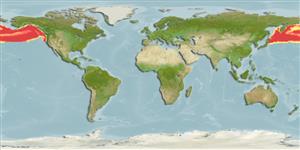>
Lophiiformes (Anglerfishes) >
Oneirodidae (Dreamers)
Etymology: Oneirodes: Greek, 'oneiros' = a dream or dreamlike or out of a dream (suggesting this fish is so strange and marvelous that can exist only in dreams) (Ref. 86949).
Environment: milieu / climate zone / depth range / distribution range
Ökologie
seewasser bathypelagisch; tiefenbereich 200 - 2000 m (Ref. 50550), usually 600 - 850 m (Ref. 86949). Deep-water; 66°N - 30°N, 142°E - 117°W
North Pacific: Okhotsk and Bering seas and off British Columbia, Canada (Ref. 11980).
Size / Gewicht / Alter
Maturity: Lm ? range ? - ? cm
Max length : 23.0 cm TL Männchen/unbestimmt; (Ref. 56582); common length : 14.8 cm TL Männchen/unbestimmt; (Ref. 56582); max. veröff. Gewicht: 450.00 g (Ref. 56582)
Kurzbeschreibung
Bestimmungsschlüssel | Morphologie | Morphometrie
Rückenflossenstacheln (insgesamt) : 0; Rückenflossenweichstrahlen (insgesamt) : 6 - 7; Afterflossenstacheln: 0; Afterflossenweichstrahlen: 4; Wirbelzahl: 19. Escal bulb bearing an anterior appendage with numerous long filaments at its distal end, a pair of medial appendages with highly branched filaments, a short round papilla and posterior appendages with 2 short filaments (Ref. 559).
Characterized by having similar characteristics like that of O.eschrichtii and O.anisacanthus; posterior margin of the upper part of subopercle is indented to deeply notched; length of ventral fork of opercle 28.6-35% SL; ratio of lengths of dorsal and ventral forks of opercle 0.55-0.60; absence of epibranchial teeth; presence of teeth on pharyngobranchial II; upper jaw teeth 23-39; lower jaw teeth 24-40; teeth on vomer 4-8; dorsal fin rays 6-7; anal fin rays 4; pectoral fin rays 15-18; head length 37.6-49.1% SL; head depth 39.1-50.8% SL; length of premaxilla 29.1-38.6% SL; lower jaw length 44.1-56.1% SL; illicial length 23.1-38.6% SL (Ref. 86949).
Life cycle and mating behavior
Geschlechtsreife | Fortpflanzung | Ablaichen | Eier | Fecundity | Larven
Masuda, H., K. Amaoka, C. Araga, T. Uyeno and T. Yoshino, 1984. The fishes of the Japanese Archipelago. Vol. 1. Tokai University Press, Tokyo, Japan. 437 p. (text). (Ref. 559)
IUCN Rote Liste Status (Ref. 130435: Version 2024-2)
Bedrohung für Menschen
Harmless
Nutzung durch Menschen
Tools
Zusatzinformationen
Download XML
Internet Quellen
Estimates based on models
Preferred temperature (Ref.
123201): 1.6 - 3.7, mean 2.3 °C (based on 51 cells).
Phylogenetic diversity index (Ref.
82804): PD
50 = 0.5000 [Uniqueness, from 0.5 = low to 2.0 = high].
Bayesian length-weight: a=0.01995 (0.00906 - 0.04395), b=3.01 (2.83 - 3.19), in cm total length, based on all LWR estimates for this body shape (Ref.
93245).
Trophic level (Ref.
69278): 4.5 ±0.80 se; based on food items.
Widerstandsfähigkeit (Ref.
120179): mittel, Verdopplung der Population dauert 1,4 - 4,4 Jahre. (Preliminary K or Fecundity.).
Fishing Vulnerability (Ref.
59153): Low vulnerability (13 of 100).
